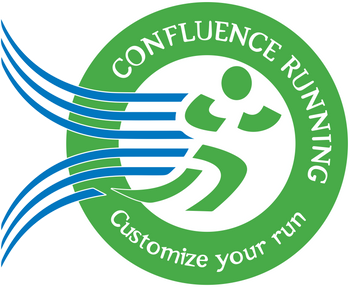Running Tips | Fueling for the Long Runs with Gels
Fueling for the Long Run with Gels
You Gellin’?
Justin DePierro
Confluence Running HV - Manager


One of the most frequent topics of conversation at Confluence Running is fueling for an endurance race and training. I find these chats fascinating because fueling strategy can be as individual as much as shoe choice. Just like shoes, everyone, including myself, is looking for that unicorn solution. Two common qualms I often hear are 1) “This is how I usually fuel, but it just doesn’t seem to work” or 2) “I know I need to fuel but can’t figure how best to do it.” In these two statements, there is a consensus that fueling for performance is not only necessary but the path to finding out what works best can be just as important as the training leading up to a key race.
First a few housekeeping items:
- We aren’t going to talk much about hydration as that is a topic for a different day.
- We aren’t going to talk about any specific diet or eating lifestyle.
- We are going to go on the presumption that we are eating to perform compared to eating (…or not) to lose weight.
Now that we have that out of the way let’s look at…
Why we fuel
It is no shock that the majority of training and race day nutrition is some form of carbohydrate. The accepted literature points to 80-90% of total energy expenditure for endurance races over 30 minutes of length derive from carbohydrates. What about the other 10% you ask? That is the tiny portion of fat needed to combine with the carbohydrate to complete the process of making your muscles contract under long periods of moderate to high aerobic efforts. So yes, carbs and fat are a runner’s friend, carbohydrates much, much more so. Our body likes sugar and it’s exceptionally good at burning carbohydrates as fuel.
Storage Capacity
The big limiting factor is storage capacity. These carbohydrates are stored in the muscles for easy access; however, they only hold enough for just about two hours of moderate to intense activity. What does that mean? Well, that is the great equalizer. Whether you’re Eliud Kipchoge or running you’re first Marathon, you need to find a fueling solution to get you across 26.2 miles at peak performance.
Rule of Thumb
The general rule of thumb is at least 40g-60g of carbohydrates every hour for runs going longer than 75-90 minutes. In my experience, 40g is the absolute, concrete floor, with 60g being a real soft ceiling. If you can get more, great. This is achievable by consuming two of almost any sports gels every hour. Most gels come packed with around 20-30g of carbohydrates, with some even exceeding 40g. That makes taking a gel every 25-45 minutes, dependent on size and density, a good place to start when it comes to planning long runs and races.
About Gels
When it comes to gels, there are a wide variety to choose from and I recommend that you try many of them. Just like shoes choice, one shoe that works for your friend may not necessarily work for you, because we all have different feet and we all have different guts. Nutrition is the same way. While your friends may love GU or Spring Energy, maybe there’s another gel like Honey Stinger or HUMA that works for you. Taste, consistency, effectiveness, packaging, and dietary needs, amongst other factors, will play a role in gel choice. There are even caffeinated gels that may give you a nice bump mid-way through the race.
How-to-Guide
There are some tips and tricks to accomplishing the seemingly daunting task of ingesting any fuel mid run, let alone a key race.
- Practice, practice, practice. In your long runs and long workouts leading up to race day have nutrition planned out to mirror race day strategy. The earlier you can introduce this in your training schedule the better off you will be. The gut is just like any muscle, it’s trainable.
- It is recommended that gels be taken with a water chaser. Now I’ll be honest, this many times doesn’t work out for logistical reasons and timing. However, the water will facilitate taking in the gel, will help with hydration, and get the nutrients transported throughout your body easier.
- Find a carrying system. Whether that’s a pack, a belt, or shorts with built in pockets, finding the right carrying vessel for your gels is important. Tip – if your gels make your favorite shorts too heavy or move around too much, paper clip them to the waist band or pocket to lock them down. With this method, you can even pre rip the gels, and fold over the top.
- Try to take all the gel. Take your time over the course of ¼ - ½ mile to get the entire gel down and digested. Don’t panic and force a gel every 30 minutes on the dot if it means you’ll be spending a lot of energy getting it down. Relax, you have time.
- With the above, knowing your course, your expected pace, and where you’ll be at certain times is to your advantage. You can plan nutrition with water stops if that helps get all of it down. *don’t wait too long, we’re talking maybe +/- 5 minutes here*
- Also with the course, try not to take gels if you’re working hard up a hill and your heartrate is super elevated. If you know you’re going to crest the top and be headed down hill shortly, or you know there’s a particularly tough hill coming up, it’s probably better to work your gel around those hills. *Once again, don’t wait too long, just be mindful*
Other Fueling options and considerations
I know gels aren’t for everyone. Luckily there’s a few other solutions, plus some other tidbits to think about:
- If you’re wearing a pack, you could bring a Drink Mix, like Tailwind, to have fuel in liquid form on you. Drink mixes also make great pre-race options for runners who don’t like eating too many solids the morning of a race, or could be used in addition to a typical pre-race breakfast.
- Sports gummies, waffles, and bars are also an option for those who prefer solid food and can run and eat at the same time (I’m envious). I know the gummies are popular, I would just check with the labels with serving size. I hear of people taking 1 gummy every half hour thinking they are getting enough carbs or calories; however, the serving size is 3 gummies. Make sure you are taking more gummies or more frequently to make up for the difference.
- I also recommend early in your buildup practicing your pre-race meals, both breakfast and dinner prior to long runs and long workouts. I’m not a registered nutritionist so I won’t prescribe any routine for you, but in the same sense that you’d want to practice what you’ll be eating in the race you’d want to practice what you eat leading up to it.
- I’d be careful with the big carb load in the 24 hours before the race. Unless you’re practicing every week to engorge yourself before your long run, you can probably hold off on the 5 servings of spaghetti. This can lead to GI issues, bloating and feeling sluggish. In the days leading up to the big dance you should be increasing your carbohydrate intake at every meal in a reasonable manner. Instead of having 1 or 2 hulking meals, you could space them out over 9-12. Yes, it is very possible, and even likely, you will gain weight in your taper week. It’s normal, as carbohydrates hold water very well. You’ll be more than fine and will be better for it. Think about it… when you fill your car up with 10 gallons of gasoline, your car gets heavier, but it will also be able to move longer.
- One popular trick the pros use is the Slosh. When you get to those late stages of the race and you cannot fathom putting anymore gels or Gatorade or even water in your belly, the act of just sloshing a sugary sports drink around your mouth can send some of the same brain signals (and in return gut signals) as drinking the real thing.
- What about the half marathon? That depends on how fast you run it. I would say anyone pushing over 90 minutes in the half should intend on and be practicing using sports nutrition. Even those in the 75 minute range should consider a few options if they feel fatigued at the tail end of the race.
I hope this information can help you succeed in your next long, endurance endeavor. Our doors at Confluence Running are always open and we love talking about running, racing, training and everything that goes a long with it. I know that performance nutrition strategies can be frustrating and sometimes more difficult than figuring out the training, but I also know there’s many options. You just need to try everything and see what works for you, and don’t let a few bumps in the journey discourage you.


